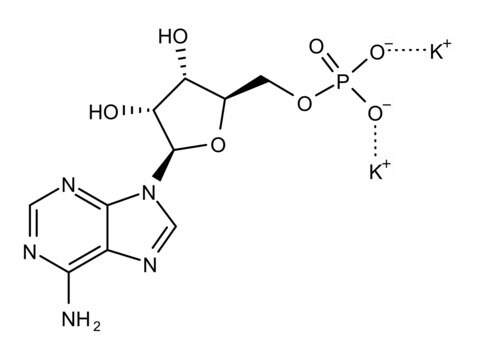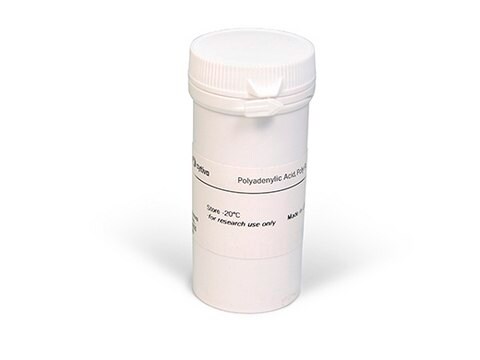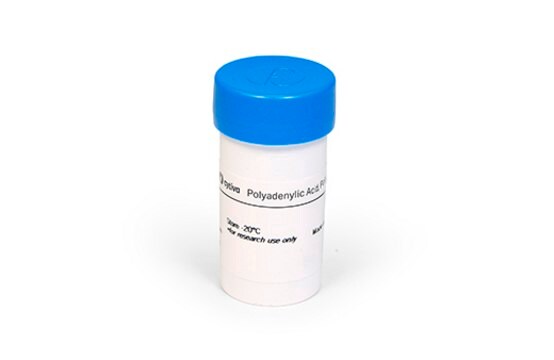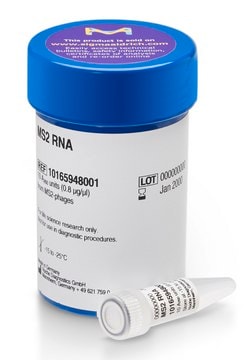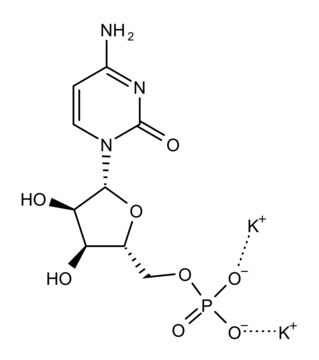10108626001
Roche
Poly(A)
lyophilized, suitable for PCR, pkg of 100 mg
Sinônimo(s):
Poly(A), Polyadenylic acid
Faça loginpara ver os preços organizacionais e de contrato
About This Item
Código UNSPSC:
41105600
Produtos recomendados
descrição
Polyadenylic acid
Nível de qualidade
Formulário
lyophilized
peso molecular
700-3500 kDa
embalagem
pkg of 100 mg
fabricante/nome comercial
Roche
concentração
0.5 mg/mL (Working concentration)
técnica(s)
PCR: suitable
cor
white
solubilidade
water: soluble
razão de absorbância
A290/260 nm 0.03-0.05
A280/260 nm 0.28-0.32
A250/260 nm 0.86-0.90
temperatura de armazenamento
2-8°C
Descrição geral
Poly(A) is used as a carrier for quantitative precipitation of DNA and RNA.
Aplicação
Poly(A) has been used for droplet digital PCR (ddPCR) assay.
Polyadenylic acid (Poly(A)) to inhibit Exo1′s exonuclease activity. It has also been used as a carrier to resuspend lyophilized gBlocks.
Ações bioquímicas/fisiológicas
Polyadenylic acid (Poly(A)) tails present at 3′ end are produced in the cell nucleus. It contains ~250 nucleotides in mammalian cells. Poly(A) regulates mRNA decay and the initiation of translation. Cytoplasmic poly(A) extension modulates translation.
Qualidade
Typical analysis:
2.3μmol/mg Poly(A) (from absorbance) in relation to one mononucleotide unit. Chromatographically homogeneous.
Absorbance determination A250/A260, A280/A260, A290/A260
2.3μmol/mg Poly(A) (from absorbance) in relation to one mononucleotide unit. Chromatographically homogeneous.
Absorbance determination A250/A260, A280/A260, A290/A260
Sequência
Chain Length 2.100 to 10.000 nucleotides
Definição da unidade
1 A260 unit corresponds to 40 μg ssRNA.
forma física
Lyophilizate, potassium salt
Nota de preparo
Working concentration: 0.5 mg/ml
A concentration of 0.5 mg/ml is recommended.
Working solution: 0.5 mg/ml is recommended.
A concentration of 0.5 mg/ml is recommended.
Working solution: 0.5 mg/ml is recommended.
Outras notas
For life science research only. Not for use in diagnostic procedures.
Código de classe de armazenamento
11 - Combustible Solids
Classe de risco de água (WGK)
WGK 1
Ponto de fulgor (°F)
Not applicable
Ponto de fulgor (°C)
Not applicable
Escolha uma das versões mais recentes:
Já possui este produto?
Encontre a documentação dos produtos que você adquiriu recentemente na biblioteca de documentos.
Poly (A) tail length is controlled by the nuclear poly (A)-binding protein regulating the interaction between poly (A) polymerase and the cleavage and polyadenylation specificity factor
Kuhn U, et al.
The Journal of Biological Chemistry, 284(34), 22803-22814 (2009)
Yuichiro Miyaoka et al.
Scientific reports, 6, 23549-23549 (2016-04-01)
Precise genome-editing relies on the repair of sequence-specific nuclease-induced DNA nicking or double-strand breaks (DSBs) by homology-directed repair (HDR). However, nonhomologous end-joining (NHEJ), an error-prone repair, acts concurrently, reducing the rate of high-fidelity edits. The identification of genome-editing conditions that
Poly (ADP-ribose)-binding promotes Exo1 damage recruitment and suppresses its nuclease activities
Cheruiyot A, et al.
DNA Repair, 35, 106-115 (2015)
Peiguo Yang et al.
Cell, 181(2), 325-345 (2020-04-18)
The mechanisms underlying ribonucleoprotein (RNP) granule assembly, including the basis for establishing and maintaining RNP granules with distinct composition, are unknown. One prominent type of RNP granule is the stress granule (SG), a dynamic and reversible cytoplasmic assembly formed in
Nossa equipe de cientistas tem experiência em todas as áreas de pesquisa, incluindo Life Sciences, ciência de materiais, síntese química, cromatografia, química analítica e muitas outras.
Entre em contato com a assistência técnica